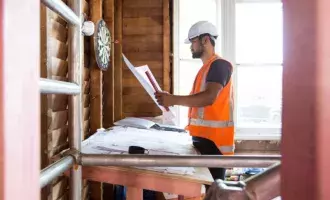The pressures facing the UK social housing sector in meeting an ever-pressing decarbonisation agenda are huge.
It’s well known that homes are a major contributor to the climate crisis. Powering and heating buildings account for 40% of the UK’s total energy use, with England’s homes alone emitting more carbon emissions every year than all the country’s cars, according to the National Housing Federation.
Plans to decarbonise the nation’s housing stock were laid out last January by the government via its Future Homes Standard consultation. It confirmed plans to ban gas boilers in new homes from 2025, whilst proposing tighter energy efficiency standards on existing properties, in a move it hopes will bring us closer to meeting our legally binding net-zero 2050 target.
With 2.7 million of the country’s homes owned by housing associations and a further 1.6 million owned by local authorities, the challenges in delivering these targets will be felt no more acutely than by social landlords – particularly when you consider many are still grappling with the complexities and costs associated with bringing their stock up to building safety standards against a backdrop of depleting resources and severely restricted budgets.
Harnessing the power of data
This is why now is the time for the sector to harness the power of their existing data to help tackle these challenges head-on without compromising their core values of delivering critical homes and services to those most in need.
For more than a decade, social landlords have been collecting data on their housing stock and tenants for reasons spanning tenant onboarding to compliance, regulation and warranty, but until now many have yet to use and analyse this data effectively to work out how efficient their stock is and where they could save money in the short and long term.
Part of the problem is how that data is stored. It’s not uncommon for social landlords to use multiple systems as part of their housing management. They might, for example, have one system that manages rental income and arrears, one that collects information on maintenance and repairs, and another that covers compliance. For many “a system” could be as basic as a spreadsheet, with data manually maintained by staff.
The challenge with this – aside from such high levels of manual administration being open to human error – is the data analysis that takes place in the sector today tends to be very static. Too often landlords will report on figures after they’ve happened, rather than actually being able to use the data for proactive and scientific analysis to drive business decisions. But by simply integrating this wide variety of information within one housing management system, social landlords could make sounder investment decisions around decarbonising their stock whilst balancing the needs of their tenants.
Take the replacement of gas boilers with heat pumps as an example. This has been put forward as one solution to reducing carbon emissions within existing properties, but could do more harm than good in the short term, without targeted data analytics.
A social landlord might want to install a heat pump in one of its 50-year-old properties to reduce the building’s emissions as a quick win to help decarbonise its stock. But only when you start to pull together information on the property does a different story come to the fore.
Its stock condition data, for example, might show the home hasn’t been properly insulated (a likely scenario in a property of this age) and its separate tenant records could show several months of rent arrears, (an increasing possibility as a result of the economic impact of the pandemic). The poor insulation would mean the home would likely lose excessive heat, something that can make heat pumps far less effective, which could drive up the cost of the tenant’s energy bills. With their financial situation already stretched, this could force them into fuel poverty.
Simplicity in integration
It’s important to note, this isn’t about complicating processes; it’s about using the information that social landlords already have at their fingertips in a more joined up way.
That said, there are wider data sets beyond those collected by social landlords that could be applied to a single system, the applications for which are really exciting, particularly in regard to the decarbonisation agenda.
Capita, for example, runs the smart metering network in the UK, which gives us unique insight into energy performance data in over 20 million homes, which we can share with our customers for analysis.
For instance, we could use a tenant’s accurate energy consumption data, collected via their smart meter, to unveil important unknowns. This could show a tenant is living in a house categorised as energy efficient, whilst also having high energy bills.
This flag would prompt a more thorough analysis. The social landlord could then look at some of the causes and analyse whether the property is being heated properly or whether this is causing dampness or poor living conditions, or even if it’s affecting the property’s infrastructure. Further areas could be tracked, such as what type of insulation or boiler was being used, right down to the light bulbs that were installed.
By looking at the building from an energy supply and demand perspective, we can assess the property’s condition and in turn the living conditions for the tenant so any concerns can be automatically red-flagged.
This same data analysis can also be used to help social landlords secure government funding to support their net-zero carbon agenda. We’re working with a number of councils and social landlords in this area and in one recent example helped an organisation secure £6m to kick start their decarbonisation programme, which was supported through accurate and integrated data.
A reasonable concern amongst anyone looking at using tenant data is obviously GDPR, due to the information’s sensitivity. However, this is not a problem if landlords are able to make a compelling case as to why they need the information, such as ensuring improved tenant conditions.
Elsewhere, a wider benefit of using a single system is that it can automate data tracking where appropriate, minimising the need to disturb tenants. This can be done by assessing, say, 10% of houses on an estate and then extrapolating those results to the whole estate.
By combining this process with collated housing improvements data registered with the local authority (something required by law for any improvement such as window glazing or change of heating), data can be collected without the need for excessive surveying, consequently saving landlords time and money.
Ultimately, the key here is to provide tenants with warmer, greener and cheaper homes, whilst delivering a more-tailored level of service. By using effective, efficient datasets, both can be done hand-in-hand with benefits for landlords, the government and tenants alike.

Glenn Allan
Head of Product – Housing, Capita One
Glenn joined Capita in 2011 after spending over 20 years working with large private sector organisations and social housing providers. Glenn now leads the housing product team for Capita one, which is made up of proven sector specialists who drive forward innovation in social housing software.







